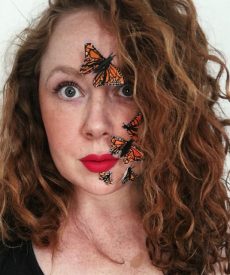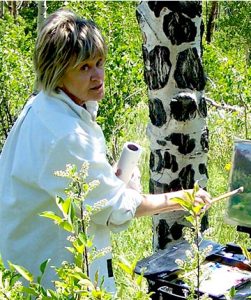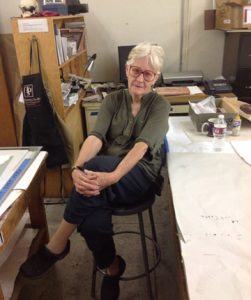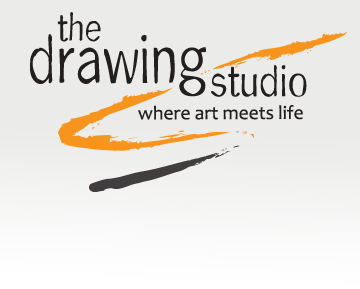The only clear path is the one the artist looks back on.
I’m saying this because if you think art making feels confusing, or frustrating, or even impossible, we get it. We’ve been there. The journey toward mastering an artistic skill, or finding the practice that’s right for you, is not an easy one – and especially if you’re used to succeeding right away.
I talked to four Drawing Studio artists about how they developed their own art practice. How did they hear, or validate, that quiet voice encouraging them to create? How did they find their way to claiming the “artist” identity with confidence? Take from their stories the kernels of truth that apply to your own life, whether you’re learning something entirely new or in the middle of a transition.
Consider a new creative direction.
What we mistakenly attribute to creative talent is often the culmination of years of searching, trial and error. Consider that all of life’s experiences are a part of the artist’s journey.

Marcy Ellis
TDS youth instructor Marcy Ellis was studying retail and merchandising at the University of Arizona when she took a trip with classmates to Guatemala. They visited a school for deaf and blind children to donate art and other supplies. The trip changed Marcy’s life.
“I saw these precious humans who didn’t have crayons and paper and pencils – things I had boxes of under my bed at home,” she said. “I had this realization that I wanted to do something with art and children. I didn’t want to sell clothes all day – I wanted to help people.”
Marcy changed her major to art education and studio art, realizing that to teach art, she also needed to be the best artist she could. But getting rooted in an art practice didn’t turn out to be easy.
“I had a rough time for two years,” she continued. Then, by chance, she registered for an intaglio printmaking class. “With printmaking, I could be expressive with line, and it was delicate, and it was what I had been searching for,” Marcy said. “I found an art form that I never knew existed . . . I found where I was supposed to be.”
Take the next step.
Sometimes we worry about the destination – where we’ll ultimately end up – rather than just taking a single step in the right direction.

Judy Nakari
Watercolor and oil painting instructor Judy Nakari was a new mother with an infant son when she signed up for her first art class. She and her husband had a very pragmatic problem: they had no money and nothing to decorate the walls of their new home.
So Judy set out to make her own art: “I knew I wanted to do something creative. I just did.” The former flight attendant registered for an adult education watercolor class on Saturday mornings – the only day her husband could take care of the baby.
“When I was home during the week, I would get out my paints in the living room and put the baby for his nap,” she continued. “It was something creative to do and I could do it. I wasn’t totally frustrated, you know what I mean?”
Judy didn’t set out to be a professional artist, or even teach. “My aspirations were just to get to know how to do this, and I really wanted to have something on my walls. But it has fulfilled me the rest of my life.”
“Don’t sit around waiting for something to happen,” she added. “Make things happen.”
Be kind to yourself.
Finding a creative path will often feel frustrating and lonely. We can pay too much attention to the voice of self-doubt and the fear of failure. Be gentle with yourself.

Rameen Ahmed
“I always loved art, and I took every class possible,” said youth and composition instructor Rameen Ahmed. “But in college, I never thought majoring in art was an option for me. I never thought I was talented enough – as if I had to be Rembrandt.”
Rameen loved the artistic process but was never satisfied with her work. So she pursued a degree in architecture instead. Architecture fulfilled her creative yearnings yet focused on tangible results.
After a decade of working in the architecture field, she found herself in a metals class. “I went into class thinking, ‘Oh, I’ll have a fun hobby on the side,’” she said. “And then on the second day, I realized, ‘I love this. This is it. . . . Ok, now how am I going to change my life?’”
Rameen’s art and architecture training came together in a medium that totally engaged her. She let go of the pressure to be perfect.
“I wasn’t always happy making art, and that’s why I didn’t pursue it,” she said. “What’s interesting to me is after all of these years, going back to art, especially teaching art, I’ve become much more kind to myself. I try to share this balance with my students – self-critique for growth, and acceptance for the learning process.”
Now is the time to get creative.
It’s now or never. If you hear an art practice calling you, listen to the voice! Stop procrastinating. Don’t waste any more time.

Ka Fisher
“I didn’t really ‘own’ that I was an artist until my 40s,” said printmaker Ka Fisher, who majored in studio art as an undergraduate at West Texas A&M University, and then pursued careers restoring furniture, teaching high school art, and other jobs.
“The 60s rolled in and I rolled in with them,” she laughed. “I wasn’t making good art; I was pursuing other things.”
“It didn’t start for me in undergraduate school. It sort of did, and I could tell stories about that, but I went underground. My fear was of success, and of failure. I was very shy at the time and drugs and drinking eliminated that . . . but it impeded me.”
Then Ka’s respected and beloved aunt and her brother sat her down. “You’ve go to do something about this,” they said. “Your entire training is in art. Pursuing it is now or never.”
“I got the push and the permission,” Ka continued. “I had lost a lot of years restoring furniture, even though the work also taught me about finishings in my painting. So I said, ‘Yes. They’re right.’’’
“I made a plan,” she continued. “Well, I don’t know if the plan was really a plan . . . I just determined I had to start.”
If you see yourself in one of these stories, it might be time to take action. TDS offers many places to begin a new studio art practice, or deepen an existing one, with classes for all levels. We’re here to help you answer your own creative call.
– Stephanie Balzer, executive director
Get more content like this, plus stay up-to-date on TDS classes, by subscribing to our e-newsletter.


